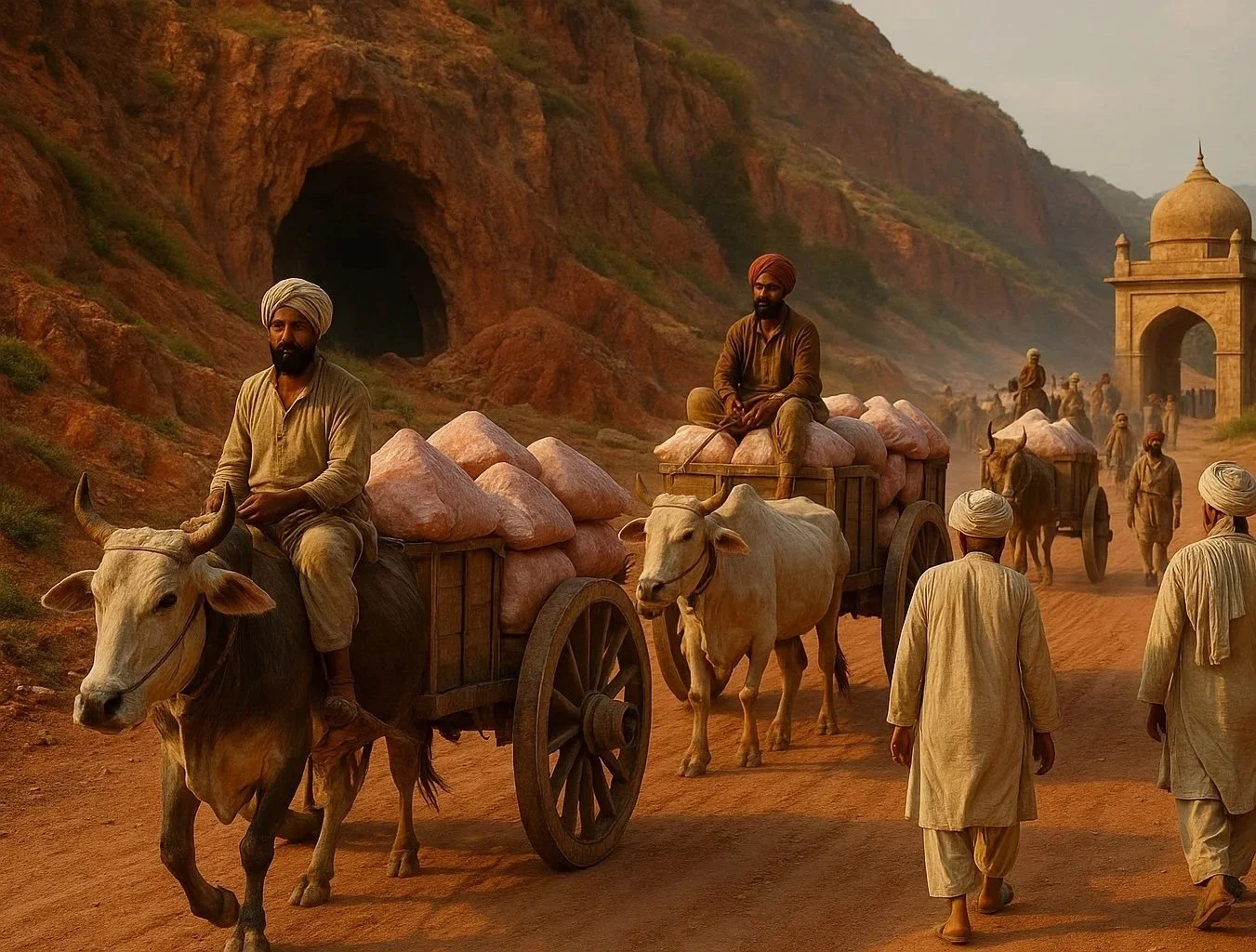The Punjabi Salt Trade
The Forgotten Trade:
Salt - one of the oldest and most essential commodities in human history. But in Punjab, salt wasn’t just a kitchen staple; it was the core of an ancient trade that shaped the region’s economy, politics, and livelihoods. From the earliest civilisations to the modern era, Punjab’s salt trade influenced empires, commerce, and even the average person. Despite its prominence the once-thriving industry is seldom spoken of today, being slowly overshadowed by more famous chapters of Punjab’s past. Let’s turn the pages back.
Punjab’s Natural Treasure – The Salt Range
The Salt Range stretches across northern Pakistani Punjab, lying between the south of the Potohar Plateau and north of the Jhelum River. It has been a key site of salt extraction for centuries. It has some of the world's oldest salt deposits and largest mines, dating back to the Indus Valley Civilisation - approximately 4,500 years ago. Archaeological evidence suggests that the people of Harappa and Mohenjo-Daro - cities within the Indus Valley Civilisation, used salt from these mines, making Punjab a crucial centre of salt production long before recorded history. The famous pink Himalayan salt originated from these deposits.
The Khewra Salt Mines are often linked to Alexander the Great through a story of his horses licking the ground when his army passed through Punjab in 326 BCE. This is said to have led to the discovery of salt deposits, but the Indus Valley Civilisation’s use of the salt predates this event significantly. Local communities likely engaged in salt extraction long before Alexander’s arrival. Over time, rulers and merchants developed sophisticated methods to extract, store, and transport salt, ensuring a steady supply across the region.
Note: The Salt Range is a geological formation in the Potohar Plateau, at the base of the Himalayas, containing vast deposits of rock salt. It stretches across Jhelum, Chakwal, and Khushab districts. Within this range are multiple salt mines, the most famous being the Khewra Salt Mine, located near the village Dadan Khan in the Jhelum District. While the Salt Range refers to the entire area rich in salt reserves, the Khewra Salt Mine is a specific site where salt extraction takes place.
The mughal influence over the salt trade
Under the control of the Mughal empire, Punjab’s salt trade became highly organised and deeply integrated into the empire’s economy. Salt was a source of revenue, power, and control. The Mughals imposed taxes on salt production and distribution, making it a major contributor to state finances. The revenue funded infrastructure, military campaigns, and administrative reforms, all which strengthened imperial control.
Punjab’s salt moved through well-established trade networks, reaching cities like Delhi, Lahore, and Bengal. Caravans carried salt across the subcontinent, making it accessible to common people while enriching traders and the empire alike. The Mughals maintained forts and outposts near the salt mines to secure production, regulate trade, and prevent smuggling.
One of the most important trade arteries for Punjab’s salt was the Grand Trunk (GT) Road - an ancient route, originally developed during the Maurya Empire and expanded under Sher Shah Suri in the 16th century, connected South Asia to Central Asia. Stretching from Chittagong (modern Bangladesh) to Kabul (modern Afghanistan). The GT Road allowed Punjab’s salt to travel far and wide. The road was crucial for the Mughal economy, facilitating movement of goods, military troops, and traders. Punjab, positioned strategically along this route, became a hub of commercial activity.
The British Salt Monopoly
Under British rule, Punjab’s salt industry declined. The British East India Company imposed heavy taxes on local salt production while favouring salt imports from other regions under their control. The Salt Laws restricted local extraction, forcing Punjabis to buy expensive, imported salt instead of producing their own. The economic burden weakened local industries and strengthened British dominance over trade in the subcontinent.
The salt taxation led to widespread resistance. In 1930, Mahatma Gandhi launched the Salt Satyagraha - a policy of passive resistance aimed at breaking the British salt monopoly in Gujarat - a state in India. Though the movement was centred outside Punjab, it had ripple effects across the region. Punjabis, recalling the days when their salt trade had thrived, defied British restrictions. Smuggling and underground trade networks emerged, as communities sought to bypass taxation and reclaim control over natural resources.
The Decline of Punjab’s Salt Trade
By the time India and Pakistan gained independence in 1947, Punjab’s salt industry had already lost its former prominence. Partition divided the region, and the major salt mines including Khewra became part of Pakistan. The Indian Punjab, once a key player in the salt trade, lost access to its primary resource. While Pakistan revitalised its salt industry, Indian Punjab began relying on salt from Rajasthan and Gujarat.
Under Pakistan’s administration, modern mining techniques were introduced to enhance productivity. The Khewra Salt Mine, now a major tourist attraction, has contributed significantly to Pakistan’s economy through global exports of Himalayan pink salt. Today, Pakistan is one of the world’s largest exporters of salt, keeping Punjab’s historic industry alive in a modern context.
Punjab’s Forgotten Industry
Despite its deep-rooted history, Punjab’s role in the salt trade is largely overlooked. The Khewra Salt Mine remains operational, attracting visitors and supplying salt globally, yet few remember how integral Punjab was to South Asia’s salt economy for centuries. Across the Pakistani Punjab, efforts to maintain and promote the salt industry have helped preserve its legacy, ensuring that Punjab’s salt continues to reach markets worldwide.
The story of Punjab’s salt trade is a testament to the region’s rich natural resources and economic legacy. While the world moves on, the salt of Punjab remains, buried beneath the Potohar Plateau, waiting for its story to be told once more.
A depiction of the salt trade during the Mughal era.
To the centuries-old salt of Punjab, may history honour your legacy, and the future hold you in reverence. With respect – TrishSaab